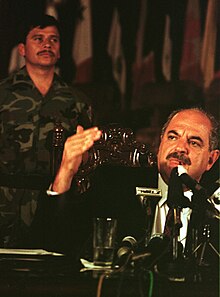1993 Guatemalan constitutional crisis
This articleneeds additional citations forverification.(May 2023) |
| 1993 Guatemalan constitutional crisis | |||||||
|---|---|---|---|---|---|---|---|
| Part of theGuatemalan Civil War | |||||||
 Serrano (right) addresses a press conference after seizing power in a military-backed surprise coup de force, 25 May 1993 | |||||||
| |||||||
| Belligerents | |||||||
|
* *Council of Ministers |
Chief Attorney General Guatemalan populace Supported by: | ||||||
| Commanders and leaders | |||||||
|
Aída de Castillo Roxana Baldetti[1] Francisco Perdomo Arturo Alvarado Pérez |
Ramiro de León Carpio Others: José Rubén Zamora | ||||||
The1993 Guatemala constitutional crisistook place in 1993 when then PresidentJorge Serrano Elíasattempted aself-coupor autogolpe. On Tuesday May 25, 1993, Serrano illegally suspended the constitution, dissolvedCongressand theSupreme Court,imposedcensorship,and tried to restrictcivil freedom.[2]
The attempted self-coup was similarto the onecarried out byAlberto Fujimori,but unlike Fujimori's, had no popular support: Serrano's action met with strong protests by most elements of Guatemalan society,[2]at the forefront of which was theSiglo Veintiunonewspaper under the leadership ofJosé Rubén Zamora.[citation needed]This was combined with international pressure (theOrganization of American Statescondemned the autogolpe[2]) and the army's enforcement of the decisions of the Constitutional Court, which ruled against the attempted takeover.[citation needed]
In the face of this pressure, Serrano resigned as president and fled the country. He was replaced on an interim basis by his vice president,Gustavo Espina.[2]However, Espina was judged by the Constitutional Court to have been involved in the coup as well, and Congress replaced him with Human RightsOmbudsmanRamiro de León.[2]
Self-coup[edit]
In the early morning hours of Tuesday May 25, 1993, President Jorge Serrano Elías suspended the Constitution, dissolved the Congress, disbanded the Supreme Court, and declared himselfdictatorfor the next two-and-a-half years.[3] He also suspended 59 articles of theGuatemalan Constitution.At the same time,Serranocalled on theSupreme Electoral Tribunalto convoke elections for a National Constituent Assembly in 60 days.[4]
Serranohad severely overestimated his support from the military and underestimated the international diplomatic reaction to his coup. Furthermore, his move had the unintended effect of catalyzing opposition not only to his leadership but to the whole structure of backroom military power that he had hoped would support him, bringing together an unlikely coalition of progressive business interests, human rights groups, andMayaactivists that would play an important role in the1996 Peace Accordnegotiations.[5]
In one last bid to stay in office, Serrano tried to recall the Congress which he had dissolved in May. Few responded and Serrano was forced to step down. He subsequently fled toEl Salvadorunder military protection on June 2. Serrano’s departure provoked another crisis when on June 2 another of his supporters, Vice-President Gustavo Espina Salguero, proclaimed himself President. Espina was prevented from taking office on the evening of June 2 when only 44 deputies attended Congress to approve his swearing-in. On June 4, theCourt of Constitutionalityruled that Espina was not eligible for the presidency due to his support for Serrano’s coup. The Court ordered the Congress to reconvene and elect a new President within 24 hours.[6]
References[edit]
- ^"Primeros años de Roxana Baldetti en la política – Prensa Libre".
- ^abcdeBarry S. Levitt (2006), "A Desultory Defense of Democracy: OAS Resolution 1080 and the Inter-American Democratic Charter,Latin American Politics and Society,Volume 48, Issue 3, September 2006, Pages: 93–123. pp104-5
- ^Dosal, Paul J. Power in transition: the rise of Guatemala’s industrial oligarchy, 1871-1994. Westport: Praeger. 1995. Pp. 1.
- ^McCleary, Rachel M. Dictating democracy: Guatemala and the end of violent revolution. Gainesville: University Press of Florida. 1999. Pp. 105-148.
- ^Fischer, Edward F. Cultural logics and global economies: Maya identity in thought and practice. Austin: University of Texas Press, Austin. 2001. Pp. 78-79.
- ^Keesing’s record of world events June 1993. Pp. 39503.
